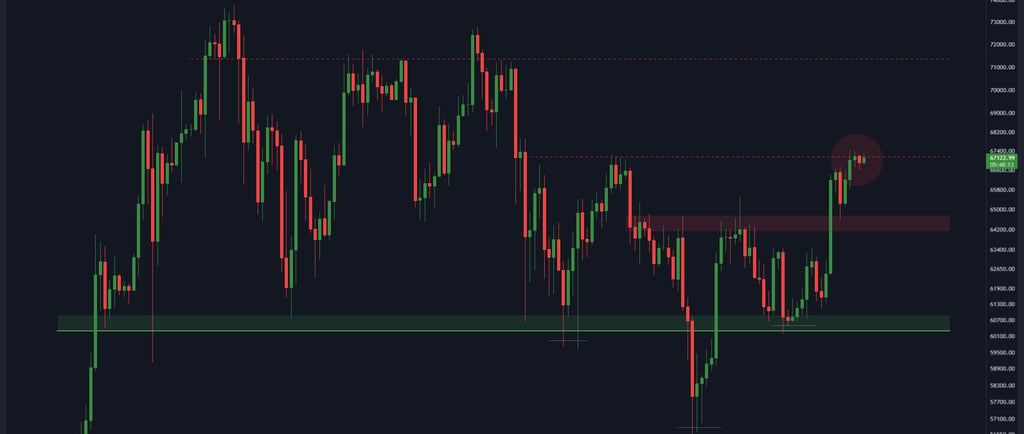Wow, Breaking Through That Resistance Could Be a Game-Changer for Bitcoin! $72K Next? Exciting Times Ahead in the Crypto Space!
5/19/20243 min read


Understanding Bitcoin's Current Resistance Level
In the realm of cryptocurrency trading, resistance levels are critical technical indicators that denote a price point where an asset, in this case, Bitcoin, has historically struggled to surpass. Traders and analysts closely monitor these levels as they often act as psychological barriers, influencing market behavior and sentiment.
Bitcoin's journey through its resistance levels has been a key aspect of its historical performance. For instance, in late 2017, Bitcoin encountered a significant resistance level around $20,000, which it failed to breach for several years. It wasn't until late 2020 that Bitcoin successfully broke through this barrier, leading to a substantial rally that saw its price soar past $60,000 in early 2021.
Currently, Bitcoin is facing a formidable resistance level around $72,000. This level has been identified through technical analysis, which involves examining past price movements, trading volumes, and other market indicators. Charts depicting Bitcoin's price action reveal multiple attempts to breach this resistance, each met with varying degrees of selling pressure.
Several factors contribute to this resistance level. Market sentiment plays a pivotal role; positive sentiment, driven by bullish news or increasing adoption, can fuel buying pressure, while negative sentiment can lead to selling. Investor behavior, particularly the actions of large institutional players, also significantly impacts resistance levels. Additionally, external economic influences such as regulatory developments, macroeconomic trends, and geopolitical events can either bolster or hinder Bitcoin's progress.
Breaking through this resistance level is considered a critical event for Bitcoin and the broader cryptocurrency market. It often signals a potential shift in market dynamics, paving the way for new all-time highs and attracting increased interest from both retail and institutional investors. Furthermore, overcoming a major resistance level can validate the underlying strength and potential of Bitcoin, reinforcing its position as a leading asset in the digital currency space.
Potential Impact of Bitcoin Reaching $72K
The prospect of Bitcoin reaching the $72K mark is a subject of intense speculation and analysis within the crypto community. Currently, the market conditions are characterized by heightened volatility and a strong bullish sentiment, largely driven by increasing institutional interest and macroeconomic factors such as inflation concerns and the devaluation of fiat currencies. If Bitcoin were to break through the $72K resistance, it could significantly impact both institutional and retail investors.
For institutional investors, a surge to $72K would likely validate their investment strategies, potentially leading to increased allocations in Bitcoin and other cryptocurrencies. This could pave the way for more mainstream financial institutions to enter the crypto space, further legitimizing digital assets as a viable investment class. Retail investors, on the other hand, might experience a surge in FOMO (Fear of Missing Out), driving up demand and potentially leading to higher prices. However, they should also be cautious of the inherent risks associated with such volatile assets.
The ripple effects on other cryptocurrencies could be substantial. A significant move in Bitcoin's price often sets the tone for the entire market. Altcoins could experience increased attention and investment, leading to broader market growth. Market sentiment would likely turn even more bullish, encouraging new entrants and fostering innovation within the blockchain ecosystem.
Expert opinions on Bitcoin's future remain varied. Some analysts predict that surpassing $72K could set the stage for even higher targets, possibly $100K or beyond, driven by factors such as limited supply and increasing demand. Others caution that such rapid price appreciation could trigger regulatory scrutiny, leading to potential crackdowns that might stifle growth in the short term.
Economically, a surge to $72K could influence regulatory perspectives, with governments and financial authorities closely monitoring the market to safeguard investor interests and ensure financial stability. Mainstream adoption could accelerate as more businesses and consumers recognize the value of incorporating Bitcoin into their financial dealings. Global financial markets might also feel the impact, as traditional assets could see capital outflows in favor of digital currencies.
In conclusion, while the potential ascent of Bitcoin to $72K presents exciting opportunities, it also comes with its share of risks. Investors should remain vigilant, conduct thorough research, and be prepared for the inherent volatility of the crypto market. The journey to $72K, if it occurs, will undoubtedly be a pivotal moment in the evolving narrative of Bitcoin and the broader cryptocurrency landscape.
